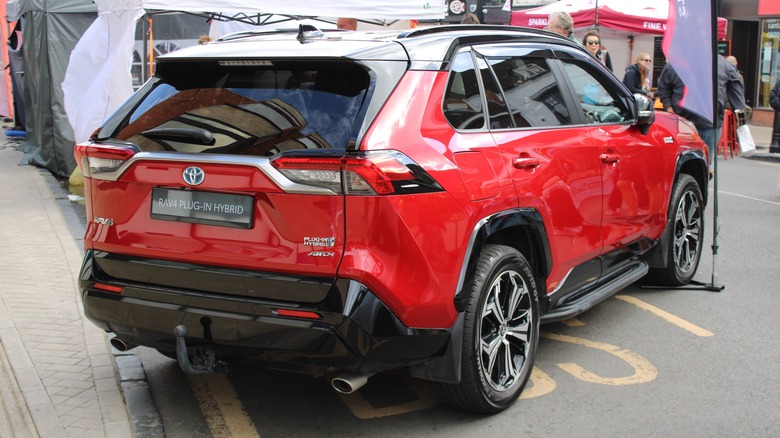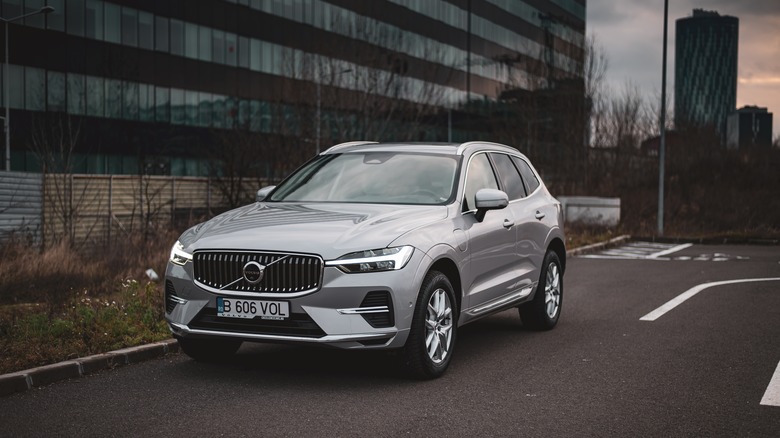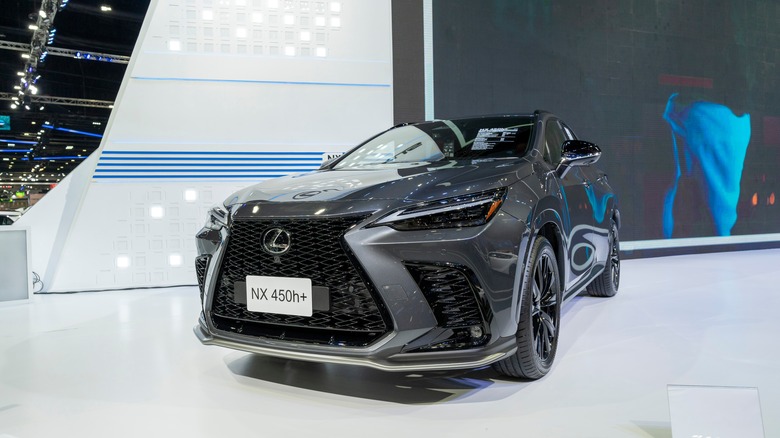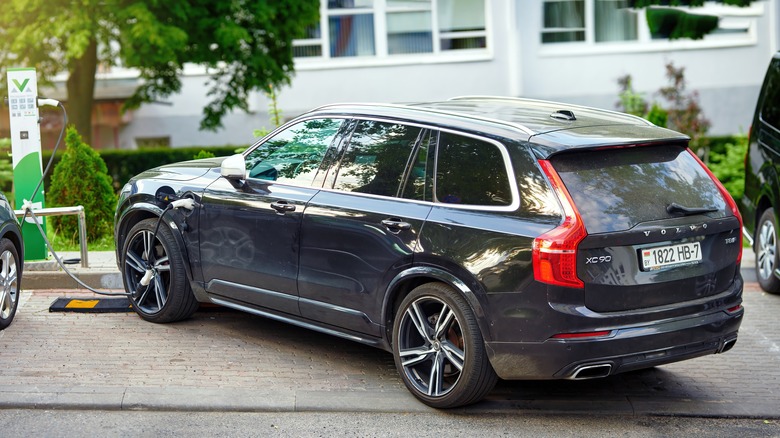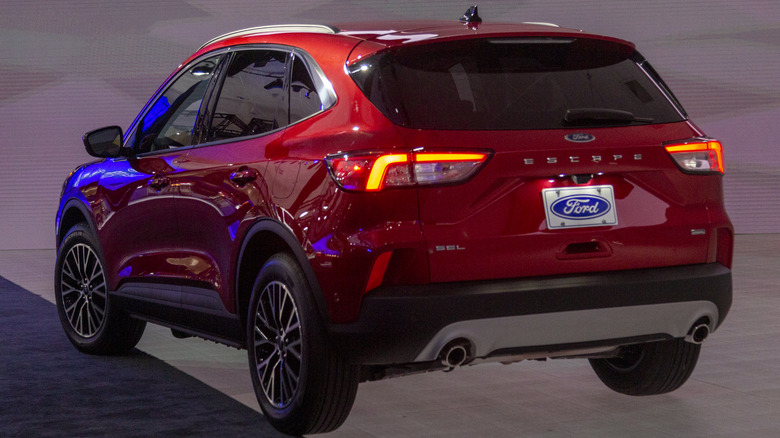The 5 Best Plug-In Hybrid Cars Ranked By Range
Plug-in hybrid vehicles (PHEV) have been a staple of the automotive market for many years. The U.S. Department of Energy notes that some of the first cars on roadways to replace horses and carriages were powered by electricity. They were soon overtaken by gasoline engines, and the manufacturing of vehicles remained laser focused on the production of cars powered by an internal combustion engine (ICE) for more than a century.
Things have changed a lot since, and the U.S. DoE notes that Toyota's 1997 hybrid Prius was the world's first mass-produced hybrid electric, with the 2010 Chevy Volt and Nissan Leaf taking this technology a step farther to offer the first PHEVs to the U.S. market.
Plug-in hybrids remain a versatile resource for drivers. They combine the long range capabilities of gasoline power with the fuel efficiency of an electric vehicle. PHEVs also combine the instant torque of an EV with the high energy output of an ICE, giving drivers a unique and exciting experience behind the wheel during acceleration, tight turning, and other typical driving conditions.
The range on some PHEV models extends far beyond the typical required driving distance that a commuter might rack up over the course of multiple weeks. These are the best five options among plug-in hybrid models, including some key factors that can help you decide on long term cash flow management and savings on fuel.
Toyota RAV4 Prime 4WD
The leader among PHEVs is the Toyota RAV4 Prime 4WD. The vehicle offers a total range of 600 miles when combining the massive, city/highway 94 MPGe statistics (via FuelEconomy.gov). The DoE also reports an unofficial estimate of 120 MPG provided by a vehicle owner directly. The Toyota RAV4 Prime PHEV includes a 2.5L, 4 cylinder engine and automatic transmission. EV Adoption reports a price tag of $41,590, and notes an 18 kWh battery to provide the electric boost.
FuelEconomy.gov adds some additional details worth noting: The RAV4 Prime's gas tank volume is only 14.5 gallons, but with the expanded electric range, this works out to a lower cost to fill the tank and a combined fuel efficiency that makes annual fuel costs roughly $950 per year. In comparison, this price tag comes in far below the total expense of many other vehicles included on this list. The RAV4 Prime also offers owners an estimated savings of $4,500 in fuel costs over five years.
Toyota enjoys a longstanding history of excellent automotive innovation, and particularly within the realm of hybrid and electric vehicles. This means that you can count on both the durability of the vehicle as a whole (as with any Toyota), and the specific components that add electric mobility.
Volvo XC60 T8 Recharge Extended Range
The next vehicle in terms of total range is the Volvo XC60 T8 Recharge, with extended range capacity. EV Adoption notes that the X60 offers one of the highest electric-only ranges in the lineup of available PHEVs, with 38 miles on the battery alone. The battery's capacity is one of the largest as well, with a rating of 18.8 kWh (topped only by the Karma GS-6 at 28 kWh). The Karma, however, offers just 360 miles of range (via Karma Automotive). The top PHEV Volvo provides 560 total miles on gas power and combined electric range.
FuelEconomy.gov reports that the Volvo XC60 runs on an all-wheel drive drivetrain, and is powered by a 4 cylinder, 2.0L Turbo engine. The car is driven with automatic transmission and costs roughly $1,500 in annual fueling. FuelEconomy.gov notes that this model will save a driver about $1,750 over five years in fuel costs. The model enjoys a combined city/highway MPGe of 63, boosted from 28 MPG on gasoline alone. It's also noted that the XC60 offers an 18.8 gallon gas tank, bringing the total capacity up above some others listed here.
Lexus NX 450h+ AWD
The Lexus NX 450h+ is an all-wheel drive model that produces a total range of 550 miles, according to FuelEconomy.gov. The Lexus PHEV sports an EPA estimated electric-only range of 37 miles through the use of an 18.1 kWh battery (via EV Adoption). The NX 450h+ offers an estimated savings of $3,500 over the fuel costs of an average new vehicle for the initial five year period of ownership.
The Lexus brings a 2.5L, 4 cylinder engine to bear, and sports automatic transmission. FuelEconomy.gov reports that the 450h+ gets 84 combined city/highway MPGe, and enjoys a competent 36 MPG on solely gasoline power. This makes the model a quality performer in fuel efficiency, whether deploying the integrated electronic hybrid power or not.
The vehicle is also fairly sizable, offering a roomy interior that's adorned with all the typical trappings that have come to be associated with the quality of the Lexus brand. With all-wheel drive included in the vehicle as well, drivers can be certain that their getting the most out of the car's performance on virtually any terrain. This adds another dimension to the vehicle's use case that makes it a heavy hitter in a number of different arenas.
Volvo XC90 T8 AWD Recharge Extended Range
The Volvo XC90 T8 Recharge (including the extended range and AWD configurations) represents the second Volvo model included here. In addition to the two that make the cut, Volvo offers three others that rank highly in total range. The XC60 and XC90 are joined by the S60 and S90, and the V60 Recharge models, all producing 500 mile ranges or better.
The XC90 T8 utilizes an 18.8 kWh battery to add 35 miles of battery-only range to its extensive total capacity (via EV Adoption). This places it within the top tier of hybrids in terms of battery capacity.
Alongside some of the other Volvo models mentioned above, only the Karma and Lexus NX 450h+ and Toyota RAV4 Prime really compete with it for battery capacity. The Volvos all bring these 18.8 kWh batteries to bear, bringing the hybrids to a pinnacle of battery technology in a vehicle that isn't a pure EV.
FuelEconomy.gov reports that the Volvo XC90 is powered by a 2.0L, 4 cylinder Turbo with automatic transmission, and 66 MPGe estimated by the EPA. The resource estimates a fuel cost savings of $1,500 over the first five years and reports an estimated annual fuel cost of $1,550. In addition to a sizable battery, the XC90 includes an 18.8 gallon fuel tank to provide 530 miles of total range.
Ford Escape FWD PHEV
This Ford Escape model claims fifth place as both a worthy inclusion and a novel brand among high performers in the total range category. FuelEconomy.gov reports that the Escape PHEV provides drivers with a total gas plus electric range of 520 miles, rounding out the five best performers at a mark well above the 500 mile threshold.
The Ford Escape offers a total MGPe rating of 105 with a small 12 gallon tank. EV Adoption notes that the battery included in the PHEV is rated at 14.4 kWh. This combination of minimized power infrastructure means that the Ford Escape PHEV must be incredibly energy efficient when it comes to the actual task of propulsion.
FuelEconomy.gov notes that the car uses a 2.5L, 4 cylinder engine and automatic shifting. This is fairly standard among PHEV models in this category, but the real standout figure is the fuel savings. It's estimated that the Escape will save a driver roughly $4,750 over the first five years, with an annual fuel cost estimate of just $900. These are the best figures of the bunch, and with a price tag of $37,960 (via EV Adoption), it's also the cheapest automobile on the list.

